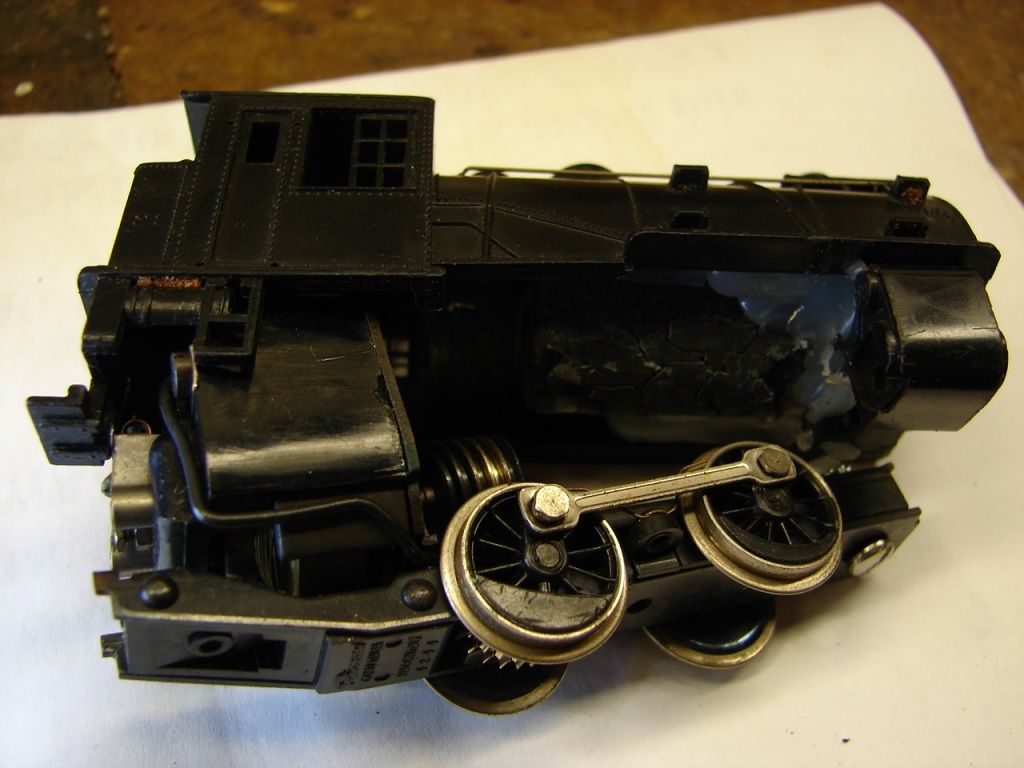 I have long had some experience with low melting point alloys and older white metal castings. Long ago I discovered that a lot of white metal castings (lead-antimony), especially of foriegn manufacture are contaminated with mercury and after a number of years will crack and, ultimately, cause the metal to crumble as mercury attacks many metals and metal alloys. As it attempts to amalgamate, mercury infects the grain structure and weakens it significantly.
I have long had some experience with low melting point alloys and older white metal castings. Long ago I discovered that a lot of white metal castings (lead-antimony), especially of foriegn manufacture are contaminated with mercury and after a number of years will crack and, ultimately, cause the metal to crumble as mercury attacks many metals and metal alloys. As it attempts to amalgamate, mercury infects the grain structure and weakens it significantly.
Such was the case found in an old Rivarossi 0-4-0 dockside that I acquired recently that was broken, but has a good motor in it. As I dimantled it, I noticed the telltale cracking and spliting all over the heavy cast engine weight. Images are above and below. I am fairly sure this is an older 1960’s vintage AHM remarket Rivarossi product
A screwdriver put in one of the cracks and twisted will break off a large chunk like it is a cookie and not solid metal. A close examination of the broken away section revealed tiny beads of liquid mercury that a straight pin could move about.
I am not saying this is common to older Rivarossi products or any other products, but is offered as a heads up. Tramp mercury is often found in poorly refined heavy metals like lead, antimony and bismuth. Modern refining methods and regulations more or less obviates this issue today.
Note** It only takes a rather tiny amount of mercury infused in a casting of this type to do this damage, but it does take a long time, (many years), to infect a casting to this degree.
Richard

I have an old Rivarossi U25 frame that has a weight that has the same problem. I stopped it falling apart by pumping the cracks full of Epoxy then coated the weight with it. That should at least stop it from falling apart.
I would resort to epoxy as well…good call, Jeff. Maybe wrap the item in tin foil or something and support it in such a way that you can slowly pour a two-part epoxy compound so that it runs between the foil and the inverted weight. Eventually it will harden and form a thin shell over the broken frame/weight. You can always sand what gets in the way of restoring the shell.
Crandell
Thanks for the heads up. I wouldn’t have known to look for that. Very useful information.
SO THAT’s what causes so-called `Zinc pest!’
Happily, the few items I owned which had the problem (old Varney trucks) have long since crumbled to dust. All of the ancient locos that ply my rails have (gasp) lead weights, so I hope I’ll be immune.
Chuck (Modeling Central Japan in September, 1964)
Zinc and Tin pests are usually associated with near arctic temperatures (~ minus 20 deg F and below) causing a phase change in those pure metals, destroying their, as cast, grain structure. Alloys with these metals in them are slightly more resistant to lower temps.
Alloys can have post casting grain swelling and shrinkage but not normally enough to crack the castings.
Remember, it only takes a tiny amount of included mercury to destroy white metal castings over time.
Richard
The photos of the castings with mercury inclusions don’t look like any zincpest with which I’m familiar. Usually, the fractured surfaces have a uniform crystalline appearance where a casting has broken apart, or it simply turns to dust. It was quite common in early soft-metal castings and was said to be caused by impurities in production. I had diecast locos with trailing trucks falling apart due to zincpest and another where the front of the main frame simply fell off. These were HO scale locos probably produced in the late '40s/early '50s, and all were in a heated basement - no -20°F except outside. [swg]
Wayne
 I have long had some experience with low melting point alloys and older white metal castings. Long ago I discovered that a lot of white metal castings (lead-antimony), especially of foriegn manufacture are contaminated with mercury and after a number of years will crack and, ultimately, cause the metal to crumble as mercury attacks many metals and metal alloys. As it attempts to amalgamate, mercury infects the grain structure and weakens it significantly.
I have long had some experience with low melting point alloys and older white metal castings. Long ago I discovered that a lot of white metal castings (lead-antimony), especially of foriegn manufacture are contaminated with mercury and after a number of years will crack and, ultimately, cause the metal to crumble as mercury attacks many metals and metal alloys. As it attempts to amalgamate, mercury infects the grain structure and weakens it significantly.